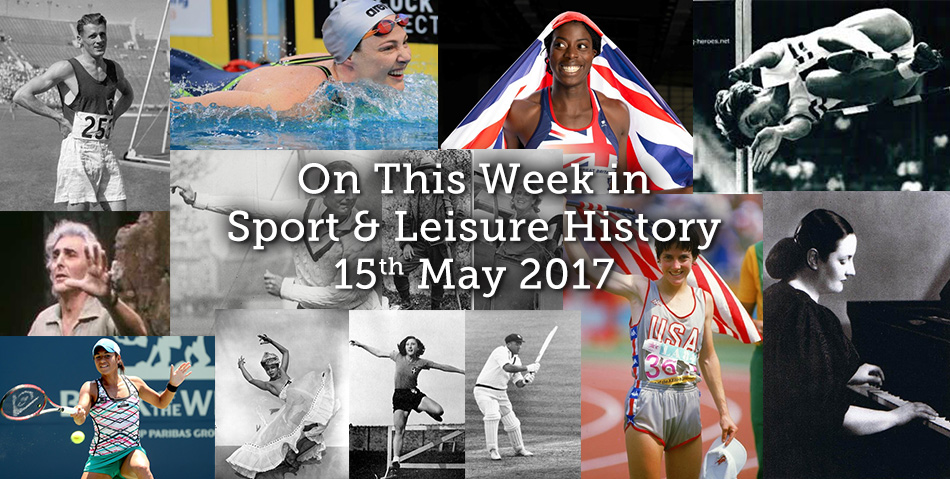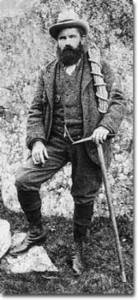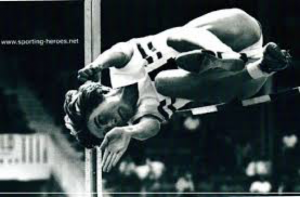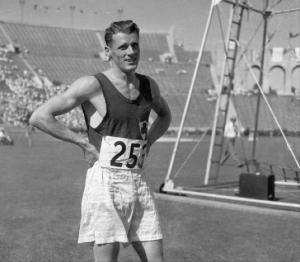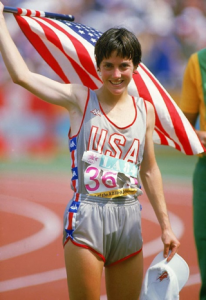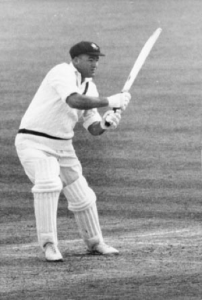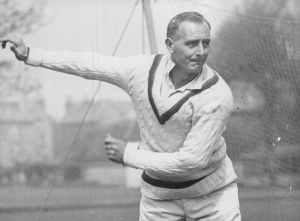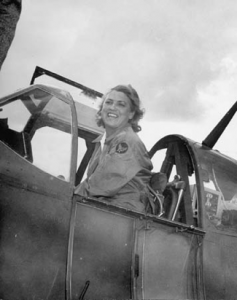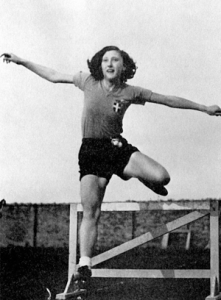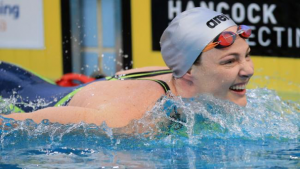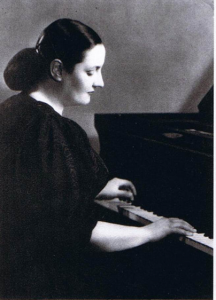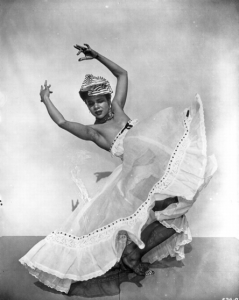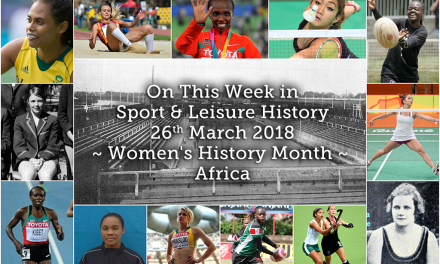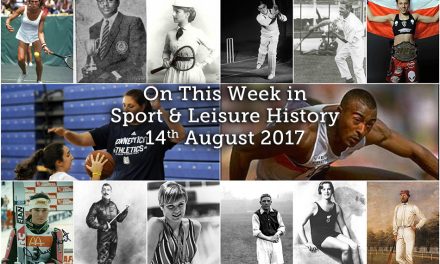15th –On this day in 1856 Matthias Zurbriggen Swiss mountaineer and one of the great 19th-century alpinists and mountain guides was born. He climbed throughout the Alps, and also in South America, the Himalayas and New Zealand. He made a considerable number of first ascents, the best known of which is Aconcagua, the highest peak in the Americas, which he climbed alone on 14 January 1897, during an expedition led by Edward FitzGerald. During the same expedition Zurbriggen also made the first ascent of Tupungato with the Englishman Stuart Vines. The Zurbriggen Ridge on Aoraki/Mount Cook in New Zealand is named after him. On 14 March 1895, Zurbriggen made the first ascent of the ridge and in the process made the second ascent of the mountain and the first solo ascent. He missed the honour of claiming the first ascent of Mount Cook, which was achieved on Christmas Day 1894 by a party of New Zealanders determined to prevent the first ascent being credited to a foreigner. Later in life, his fortune declined. He lived his last decade as a vagrant in his home country, and was found hanged in Geneva in 1917, an apparent suicide. The first baseball stadium was opened at the Union Grounds, Brooklyn, on this day in 1862. Paul Probst, a Swiss sports shooter was born today in 1869. He competed in the late 19th century and early 20th century. He participated in Shooting at the 1900 Olympics in Paris and won a gold medal with the Military pistol team for Switzerland. Welsh world flyweight champion Jimmy Wilde was born in 1892. He was known as “The mighty Atom” because of the power he could pack for such a small man. England lost their first international football match outside the British Isles in 1929 when they were defeated 4-3 by Spain in Madrid. The former England Test cricket captain Ted Dexter was born in 1935. He played first-class cricket for Cambridge University and Sussex and appeared for England 62 times. He was also an excellent golfer and won the prestigious President’s Putter competition at Rye, British high-jumper Dorothy Shirley was born in 1939, she competed for Great Britain in the 1960 Olympics held in Rome, where she won high jump silver jointly with Jarosława Jóźwiakowska. It was the fifth straight silver medal for Britain in this event. .She later went into teaching and worked as a PE teacher. A piece of history was made today in 1948: Australia scored 721 runs against Essex at Southend-on-Sea, the largest total achieved in one day’s play in a first-class game. Lisa Curry, also known by her married name Lisa Curry-Kenny, Australian swimmer was born in 1962. Curry won 15 gold, seven silver and eight bronze international swimming medals, and is the only Australian swimmer to have held Commonwealth and Australian records in every stroke except backstroke. She was an Australian Institute of Sport scholarship holder and the chair of the National Australia Day Council from 2000 to 2008. In 1963 Tottenham Hotspur became the first British winners of a European trophy when they beat Atlético Madrid 5-1 in Rotterdam to take the Cup Winners’ Cup; Jimmy Greaves scored two goals for Spurs. On this day in 1966 the first day of Sunday play in Country Cricket took place with the match between Essex and Somerset. British chess grandmaster Matthew Sadler was born in 1974. Sadler won the British Championship in 1995 at the age of 21 and again in 1997 (jointly with Michael Adams). He represented England in the 1996 Chess Olympiad, scoring 10½/13 and winning a gold medal for the best score on board four (England finished fourth), and also played in 1998 scoring 7½/12. He made 7/9 on board four for England at the European Team Chess Championship in Pula in 1997. His was the best individual score of the five-man English team and so contributed significantly to England’s first (and to date only) gold medal in a major competition. He was widely tipped to reach the heights scaled by such leading players as Michael Adams and Nigel Short but has since taken the decision to cease playing professionally, opting for a career in IT in the Netherlands. For several years, he was the book reviewer for New in Chess magazine and also wrote books and articles for other chess magazines. In 2000, his book Queen’s Gambit Declined was awarded the British Chess Federation’s book of the year award. Sadler has a French mother, speaks French perfectly and is also qualified to play in closed French events. Latterly a resident of Amersfoort, Sadler returned to chess in 2010 to play in a rapid-play tournament held in nearby Wageningen. He won the event with a maximum score of 7/7. In August 2011, Sadler continued his resurgence by winning the XIII Open Internacional D’Escacs de Sants and in October 2011 he went on to win the Oslo Chess International. In a January 2012 interview, Sadler stated that chess was now primarily a “hobby” for him. While relishing his return to tournament play, Sadler noted that he was now an amateur, and would not be coming back as a professional. He contrasts his present light-hearted attitude with his demeanour during his time as a professional, when he was “working ten hours a day and incredibly intensively”. Italian diver Tania Cagnotto was born today in 1985. She is the first Italian female diver to win a medal in a World Championship. Filipino racing car driver Jovy Marcelo, better known simply as Jovy Marcelo, was killed in practice for the 1992 Indianapolis 500 on this day in 1992 aged 27. During warm-up for the race Marcelo’s car spun and impacted on the right side entering turn one at 172 mph. He died instantly due to a basal skull fracture under the right ear. It was alleged that Marcelo’s helmet only had an anti-rotational tether strap on the left side of his head, leaving his head and neck vulnerably exposed on the right (whereupon drivers subsequently wore them on both sides as a preventative measure; the HANS Device was not mandatory until 2001). Following his death, the Toyota Atlantic Championship created the Jovy Marcelo Sportsmanship Award, which is given annually to the driver who best exemplifies the sportsmanship of Marcelo. The First Jovy Marcelo sportsmanship award was presented to Bert Hart for the 1992–1993 season. Arsenal today celebrated going an entire league campaign unbeaten today in 2004. They joined Preston North End with the right to claim the title The Invincibles. On this day in 2010 Jessica Watson became the youngest person to sail, solo, non-stop and unassisted around the world
- Matthias Zurbriggen
- Dorothy Shirley
16th – The British-American inventor, practical experimenter and professor of music, David Edward Hughes was born today in 1831. He was known for his work on the printing telegraph and the microphone. He is generally considered to have been born in London but his family moved around that time so he may have been born in Corwen, North Wales His family moved to the US while he was a child and he became a professor of music in Kentucky. In 1855 he patented a printing telegraph. He moved back to London in 1857 and further pursued experimentation and invention, coming up with an improved carbon microphone in 1878. In 1879 he identified what seemed to be a new phenomenon during his experiments: sparking in one device could be heard in a separate portable microphone apparatus he had set up. It was most probably radio transmissions but this was nine years before electromagnetic radiation was a proven concept and Hughes was convinced by others that his discovery was simply electromagnetic induction. Hughes was elected a Fellow of the Royal Society in June 1880 and won their Royal Medal in 1885. After Hughes’ death the Hughes Medal was created by the Royal Society in his honour, to be awarded to other scientists “in recognition of an original discovery in the physical sciences, particularly electricity and magnetism or their applications“. It included a gift of £1000 and was first awarded in 1902. Bob Tisdall, Irish athlete was born in 1907 in Nuwara Eliya, Ceylon now Sri Lanka, he won the gold medal in the 400m hurdles at the 1932 Olympics in Los Angeles. Tisdall was raised in Nenagh, County Tipperary. He had run only six 400m hurdles when he won his Olympic gold medal in a world record time of 51.7 seconds, which was not recognised under the rules of the time because he had a hit a hurdle. Later, because of the notoriety of this incident, the rules were changed and the President of the IOC, Juan Antonio Samaranch, presented Tisdall with a Waterford crystal rose bowl with the image of him knocking over the last hurdle etched into the glass. Though the IAAF did not recognize the record at the time, they now recognize the mark, giving Tisdall credit for setting the milestone of being the first man under 52 seconds. Later in life, Tisdall lived in South Africa, where he ran a gymnasium during the day, which he converted to a night club after dark. He grew coffee in Tanzania, but moved to Nambour in 1969 with his wife Peggy, where he farmed fruit crops and cattle. He admitted to running his last race at the age of 80, though he ran in the Sydney Olympic torch relay at age 93. At that point he was the oldest living recipient of an individual track and field Olympic medal and was offered the opportunity to present the medals for the 400m hurdles at the Sydney Olympics but declined as he felt it would detract from the attention due to the winner. At the age of 96 he fell down a steep set of rock stairs and broke his shoulder, ribs and ruptured his spleen. He never completely recovered and died on 27 July 2004, aged 97. At that time, he was the world’s oldest track and field Olympic Gold medallist. Gustaf Van Roosbroeck, Belgian professional road cycle racer was born in 1948, he competed the 1970s, and finished fifth in the 1974 Amstel Gold Race. The world famous Belarusian Olympic gymnast Olga Valentinovna Korbut was born in 1955. Nicknamed the “Sparrow from Minsk”, she won four gold medals and two silver medals at the Olympic Games, in which she competed in 1972 and 1976 for the Soviet Union. She started training at age 8, and entered a Belarusian sports school headed by Coach Renald Knysh at age 9. There, Korbut’s first trainer was Elena Volchetskaya, a 1964 Olympic gold medallist, but she was moved to Knysh’s group a year later. With him, she learned a difficult backward somersault performed on the beam. She debuted this at a competition in the USSR in 1969. In the same year, Korbut completed a backflip-to-catch on the uneven bars; this was the first backward release move ever performed by a woman on bars. She finished fifth at her first competition in the 1969 USSR championships, where she was allowed to compete as an underage 15-year-old. The next year, she won a gold medal in the vault. During the Olympics, Korbut was one of the favourites for the all-around after her dynamic performance in the team competition; however, the title went to her teammate Ludmilla Tourischeva. Korbut won three gold medals for the beam, floor exercise and team. Korbut is most famous for her uneven bars and beam routines, as well as her charismatic performances that captivated audiences. Her Olympic achievement earned her ABC’s Wide World of Sports title of Athlete of the Year. In 1973, she won the Russian and World Student Games, and a silver medal in the all-around at the European Championships. At the 1976 Olympics in Montreal, Soviet coaches and officials had designated Korbut as the woman who could beat the Romanian prodigy, Nadia Comăneci, but Korbut was injured and her performances in the games were sub-par. She was overshadowed not only by Comăneci, but also by her own teammate Nellie Kim. She did collect a team gold medal, and individual silver for the beam. Korbut graduated from the Grodno Pedagogical Institute in 1977, became a teacher and retired from gymnastic competition thereafter. She married Leonid Bortkevich, who was a member of Belarusian folk band Pesniary. In 1988 Korbut was the first gymnast to be inducted into the International Gymnastics Hall of Fame. In 1991, she and her family emigrated to the USA, because they were worried about the effects of fallout from the Chernobyl disaster on Belarus. They settled in New Jersey where she taught gymnastics. They moved to Georgia two years later where she continued to coach. Korbut and Bortkevich divorced in 2000, she became a naturalized US citizen the same year. In 2002 Korbut moved to Arizona, to become head coach at Scottsdale Gymnastics and Cheerleading. In 2017, Korbut sold her 1972 and 1976 Olympic medals amongst thirty-two lots (including two golds and a silver from the Munich Olympics) which fetched $333,500 at Heritage Auctions. This was reportedly done to “to save her from hunger” though auction house spokesman Elon Werner and Korbut herself have strongly denied this claim. Korbut is best known for her moves, both referred to as the “Korbut flip”, firstly, on beam, a back handspring to swing down to cross straddle sit and secondly on uneven bars: a backflip starting from a standing position on the high bar and then catching the same bar from below on the under swing. This particular move, named after Korbut since she was the first to perform the skill at an international competition it has since been made illegal in the Olympic Code of Points. Joan Benoit was born in 1957, the American marathon runner who won gold at the 1984 Olympics in Los Angeles in the year that the women’s marathon was introduced. As a result, she was the first-ever women’s Olympic marathon champion. Benoit still holds the fastest times for an American woman at the Chicago Marathon and the Olympic Marathon. Her time at the Boston Marathon was the fastest time by an American woman at that race for 28 years. She was inducted into the Maine Women’s Hall of Fame in 2000. Benoit took to long-distance running to help recover from a broken leg suffered while slaloming. She entered the 1979 Boston Marathon as a relative unknown, winning the race, wearing a Boston Red Sox cap, in 2:35:15, knocking eight minutes off the competition record. She repeated that success with a victory again in 1983, which took more than two minutes off the world’s best time, set by Grete Waitz in the London Marathon just the day before, despite having surgery on her Achilles tendons two years earlier. Her Boston course record of 2:22:43, set in 1983, was not broken for another 11 years. Since her retirement from competitive running, she has written books including Running Tide and Running for Women, and has opened a running clinic. She is also a coach to women’s cross-country and long-distance athletes, and is a motivational speaker and sports commentator. Argentine tennis player Gabriela Sabatini was born in 1970. Her consistency in reaching the semi-finals and finals of numerous tournaments has earned her prize money in excess of $6 million. Her only Grand Slam singles title to date is the US Open which she won in two sets in 1990, beating Steffi Graf. She also won the women’s doubles title at Wimbledon in 1988, two Year-End Championships in 1988 and 1994, and a silver medal at the 1988 Olympic Games. Sabatini’s last professional singles match was on 14 October 1996, when she lost to Jennifer Capriati 6–3, 6–4. (Capriati’s first loss on the WTA tour was to Sabatini in 1990). Sabatini played her last professional match on 19 October 1996, in the doubles semi-finals in Zürich with Lori McNeil. Sabatini retired from the professional tour in 1996, having won 27 singles titles and 14 doubles titles. She reached her highest ranking of World No. 3 in 1989. In 2001, she won the Diamond Konex Award as the most relevant Sportman of the decade in Argentina. Sabatini was inducted into the International Tennis Hall of Fame on 15 July 2006. British speedway rider Scott Karl Nicholls was born in 1978. Nicholls began his speedway career in grass track racing becoming National Schoolboy champion in 1993. His first international appearance came in 1996 when he was selected to ride for Great Britain in the Speedway World Cup final. He then became British Under-21 Champion in 1998 and again in 1999. His first experience of the Speedway Grand Prix series came with a wild card ride in Britain, with similar rides following in 2000 and 2001. He qualified as a full-time Grand Prix rider in 2002 and capped that season with a second place in the season ending event in Australia. That year he also won the first of his six British Championships. His sixth British Championship win was in 2011. Nicholls was the most successful ever Coventry Bees captain, skippering them to five trophies in three seasons between 2004 and 2007, including two Elite League championships. Despite quitting the British Elite League to reduce his racing schedule in 2009, Nicholls returned to the Coventry Bees in May 2009 as temporary cover for the injured Olly Allen. Nicholls led his home club, the Ipswich Witches for the 2010 Elite League season, as well as riding for Vargarna in the Swedish league and Miskolc, a Hungarian team in the Polish league. With Ipswich dropping down a division, Nicholls signed for Swindon Robins for 2011. After an unsuccessful spell with the Robins, Nicholls returned to parent club Coventry Bees for the 2012 season, staying there in 2013. He signed to ride for Belle Vue Aces in 2014. On this day in 1994 tennis star Jennifer Capriati was arrested on possession of marijuana. In 2005 Sony’s PlayStation 3 made its debut at the E3 trade show. Archaeologists in Patagonia, Argentina, unearthed a set of bones that appear to belong to the largest dinosaur yet discovered, today in 2014. The new creature is thought to have weighed 77 tonnes and to have stood around 20 meters tall.
- Bob Tisdall
- Joan Benoit
17th – Today in 1859 members of the Melbourne Football Club codified the first rules of Australia Rules football. On this day in 1875 the first Kentucky Derby was run in Louisville. The Derby was raced over a 1½ miles at that time and would remain so until 1896 when it was changed to the present 1¼ miles. The race was won by Aristides, one of two horses entered by Hal McGrath. The other was Chesapeake. Both horses wore the green and orange silks of H.P. McGrath. Trained by future Hall of Famer Ansel Williamson, an African American, Aristides was ridden by Oliver Lewis, also African American. Reinhold Saulmann, Estonian track and field sprinter was born in 1895. Saulmann was a five-time Estonian champion in the sprints and the 400m hurdles. He also held the Estonian records in 150m, 300m, 400m and 400m hurdles. At the 1920 Olympics he was entered in the 100m, 200m and 400m, but did not start the 100m and competed in only the first rounds of the longer sprints, his estimated time of 51.6 in the 400m heat was a national record. He also represented Estonia in bandy nine times in 1916–1918. (Bandy is a team sport played on ice and is considered a form of hockey, it has a common background with football, ice hockey and field hockey. Like football, the game is normally played in two 45 minutes halves, there are eleven players on each team, and the bandy field is about the same size as a football pitch. It is played on ice like ice hockey, but like field hockey, players use bowed sticks and a small ball). Following his retirement from active competition Saulmann took to sports administration, serving as a club treasurer and a representative to the Estonian Olympic Committee. The 9th Modern Olympic Games opened today in 1928 in Amsterdam. Australian cricketer Peter Burge was born in 1932, he played in 42 Tests between 1955 and 1966. After retiring as a player he became a highly respected match umpire, overseeing another 25 Tests and 63 ODIs. He was a Wisden Cricketer of the Year in 1965 and in 1997 was made a Member of the Order of Australia “for service to cricket as a player, administrator and international referee, and to harness racing.” Yelena Gorchakova, Russian javelin thrower was born in 1933; she won Bronze at both the 1952 and 1964 Olympics. Her 1964 bronze was a disappointment to her as she set a world record in the qualification that remained unbeaten for eight years. During her long career Gorchakova had a fierce competition within the Soviet national team and won the national title only twice, in 1963 and 1965. As a result, despite being a world’s top thrower she rarely competed internationally. Gorchakova won gold at the 1961 Summer Universiade and finished fourth at the 1966 European Championships. She retired shortly thereafter. The Argentine rugby player turned coach Marcelo Loffreda was born today in 1959. He won 44 caps with one as captain, playing at centre for the Argentine rugby union side. He played much of his career outside the legendary Hugo Porta and scored four test tries. In 1994 he hung up his playing boots and became a coach. In April 2000, he was appointed coach of Argentina and steered them to series victories over France, Wales and Scotland, a draw with the British and Irish Lions, a win against England at Twickenham as well as coming close to securing the Pumas’ first victories over South Africa and New Zealand. The Pumas went on to their all-time best finish of third at the 2007 World Cup, this success was Loffreda’s swansong as Pumas coach, as he had announced months before the tournament that he would leave the Pumas after the World Cup for the job of Director of Rugby at Leicester. Loffreda was sacked from his job as Head Coach at Leicester on June 6, 2008, after just one season at the club. Despite reaching two finals (EDF energy and Guinness Premiership) he was dismissed due to poor results. Leicester only just reached the Premiership playoffs and barely qualified for the Heineken Cup; from a club of this self-perceived standard, this was seen as unacceptable. He has returned to Argentina as a coach. The English boxer Randolph Turpin, also known as Randy Turpin, died on this day in 1966 aged 37. Turpin was considered by some to be Europe’s best middleweight boxer of the 1940s and 1950s. In 1951 he became world middleweight champion when he defeated Sugar Ray Robinson. His days as a world champion did not last long, however, and when he made his first trip outside his homeland for a fight, he lost his crown to Robinson by a tenth-round TKO with eight seconds left in the round at the Polo Grounds in New York on 12 September 1951. He finally retired in 1962 with a record of 66 wins, eight losses and one draw, of his 66 wins, 48 came by knockout. By that time he was so short of money that he resorted to professional wrestling. His name meant that he drew moderate crowds for a short time, but in the end this venture was not a success because he was a fighter not a showman. According to articles, reports and a biography, Turpin couldn’t deal with the obscurity resulting from the loss of his crown. In Llandudno he bought a public house on the Great Orme, which today retains several genuine artefacts from his career. Between 1952 and 1961, he was the registered licensee. After being declared bankrupt, Turpin committed suicide by shooting himself in May 1966. He was found dead in his home Gwen’s Transport Cafe in Leamington Spa, where he lived with his wife and four daughters. One of his daughters, Carmen aged four, was taken to hospital in Birmingham with two gunshot wounds and survived. Turpin was inducted into theInternational Boxing Hall Of Fame in 2001. Mayte Martínez Jiménez, Spanish 800m athlete, was born in 1976; she has reached four consecutive finals in the World Championships. Her third, with an incredible last straight finish in Osaka. She took part in 2000 and 2004 Olympic Games, but was eliminated at the semi-final stage. She could not participate in 2008 Olympic Games in Beijing due to a fasciitis plantar injury. Japanese Olympic swimmer Reiko Nakamura was born in 1982. She swam in the 2004 and 2008 Olympic Games, winning bronze in the 200m backstroke at both Games. At the 2008 Olympics, Nakamura set the Asian Records and Japanese records in both the 100m and 200m backstroke (59.36 and 2:07.13).At the 2007 World Championships, she swam a new Japanese 100m backstroke record (1:00.40) , winning the Bronze medal. . Eight days later, she lowered the mark to 1:00.29 while winning the 2007 Japan Championships. Christine Ohuruogu was born in 1984; the British 400m specialist is a former Olympic, World and Commonwealth champion. The Olympic champion in 2008, and silver medallist in 2012, she is a double World Champion, having won the 400m at the 2007 and 2013 World Championships. She has also won four World championship bronze medals in the women’s 4x400m relay as part of the Great Britain and Northern Ireland team and bronze Olympic medals with the women’s 4x400m relay at the 2008 Beijing Games and the 2016 Rio Games, her final Olympics. Ohuruogu’s personal best time of 49.41 seconds, set at the 2013 World Championships, beat the UK record set by Kathy Cook in 1984 by 0.02 seconds, simultaneously making her the first British female to win two World Championship titles, and the first British female to win three global titles. Her relay bronze at the 2016 Summer Olympics made her only the second British track and field athlete, after Steve Backley to win medals at three successive Olympic Games. On this day in 2000 Arsenal and Galatasaray fans clashed at the 2000 UEFA Cup Final riots in Copenhagen. Philippe Gaumont, French professional cyclist died on this day 2013 aged 40. He won bronze in the 1992 Olympic 100km team time trial and in 1997 won the Belgian classic Gent–Wevelgem and was twice individual pursuit French national champion, in 2000 and 2002. In 2004, Gaumont quit professional cycling and later ran a café in Amiens. Gaumont was well known for having confessed to extensive doping and explaining a lot of the tricks of the trade. He gave a series of interviews, and wrote a book, Prisonnier du dopage (“Prisoner of doping”) in which he explained doping methods, masking methods, the use of drug cocktails for training and for recreation, and how the need to make money makes racers dope. In April 2013 he suffered a major heart attack and was reported to be in a coma. On 13 May 2013, several news sources reported his death, but according to La Voix du Nord he remained in an artificial coma, though had suffered brain death.
- Peter Burge
- Christine Ohuruogu
18th – Denis Horgan, champion Irish athlete and weight thrower was born in 1871. Shortly after setting a world record of 48 feet 2 inches with the 16 pound shot at Queenstown, in County Cork, Ireland in 1897, Horgan visited the USA, and in 1900, he joined the Greater New York Irish Athletic Association, the predecessor of the Irish American Athletic Club for a brief period before in 1905, joining the rival New York Athletic Club. In 1906, Horgan set a world record for the 28 pound shot, with a distance of 35 feet, 4.5 inches at the Ancient Order of Hibernians games held at Celtic Park in Queens, New York. He competed for Great Britain in the 1908 Olympics winning the silver in the shot put. Denis Horgan won a total 42 shot put titles during his athletic career, including 28 Irish championships, 13 English championships (all for the 16 pound shot) and one American championship. Horgan was “usually so superior to his fellow competitors that he seldom trained in any sort of systematic way, yet he showed a marked consistency of performance, in all conditions, over a period of twenty years. Swedish long-distance athlete Eric Backman was born on this day in 1896, his best achievement was at the 1920 Olympics. He won silver in the 8000m cross-country race, 2.6 seconds behind the legendary Paavo Nurmi. This second place helped the Swedish cross-country team to win the bronze medal behind Finland and Great Britain, as two other team members finished 10th and 11th. This scenario was repeated in the 3000m team event – Backman finished second and other Swedes 10th and 12th; he pulled up the Swedish team to the third place. In the 5000m Backman finished third, again behind Paavo Nurmi. Backman was a heavy smoker and enjoyed alcohol, yet he was an eight-time Swedish champion in the 5000m and 10,000m between 1918–23, and held Swedish records over 5000m, 10,000m, 5 miles and one-hour run. Hedley Verity was born today in 1905; he was a professional cricketer who played for Yorkshire and England between 1930 and 1939. A slow left-arm orthodox bowler, he took 1,956 wickets in first-class cricket at an average of 14.90 and 144 wickets in 40 Tests at an average of 24.37. Named as one of the Wisden Cricketers of the Year in 1932, he is regarded as one of the most effective slow left-arm bowlers to have played cricket. Never someone who spun the ball sharply, he achieved success through the accuracy of his bowling. On pitches which made batting difficult, particularly ones affected by rain, he could be almost impossible to bat against. Frederick John “Fred” Perry was born in 1909; the British tennis and table tennis player was a former World No. 1, won 10 Majors including eight Grand Slams and two Pro Slams single titles, as well as six Major doubles titles. Perry won three consecutive Wimbledon Championships from 1934 to 1936 and was World Amateur number one tennis player during those three years. Prior to Andy Murray in 2013, Perry was the last British player to win the men’s Wimbledon championship, in 1936 and the last British player to win a men’s singles Grand Slam title until Andy Murray won the 2012 US Open. Perry was the first player to win a “Career Grand Slam”, winning all four singles titles at the age of 26 which he completed at the 1935 French Open. He remains the only British player ever to achieve this. Although Perry began his tennis career aged 18, he was also a Table Tennis World Champion in 1929. In 1933, Perry helped lead the Great Britain team to victory over France in the Davis Cup; the team’s first success since 1912, followed by wins over the United States in 1934, 1935, and a fourth consecutive title with victory over Australia in 1936. But due to his disillusionment with the class-conscious nature of the Lawn Tennis Club of Great Britain, the working-class Perry turned professional at the end of the 1936 season and moved to the United States where he became a naturalised US citizen in 1938. In 1942, he was drafted into the US Air Force during the Second World War. Despite his unprecedented contribution to British tennis, Perry was not accorded full recognition by tennis authorities until later in life because between 1927 and 1967, the International Lawn Tennis Federation, ignored amateur champions that later turned professional. In 1984, a statue of Perry was unveiled at Wimbledon, and in the same year he became the only tennis player listed in a survey of 2,000 Britons to find the “Best of the Best” British sportsmen of the 20th century. Dame Margot Fonteyn de Arias was born in 1919, the English ballerina spent her entire career as a dancer with the Royal Ballet, eventually being appointed Prima Ballerina Assoluta of the company by Queen Elizabeth II. At four years of age her mother signed her and her elder brother up for ballet classes. At age eight, Margot travelled to China with her mother and father, who had taken employment with a tobacco company there; her brother Felix remained at his school. For six years Margot lived in TianJin, then in Shanghai, where she studied ballet with Russian émigré teacher George Goncharov. Her mother brought her back to London when she was 14, to pursue a ballet career. In 1933 Fonteyn joined the Vic-Wells Ballet School, the predecessor of today’s Royal Ballet School, training under the direction of Ninette de Valois and such teachers as Olga Preobrajenska and Mathilde Kschessinska [Krzesinska]. After starting with the Vic-Wells Ballet, she rose quickly through the ranks of the company. By 1939 Fonteyn had performed principal roles in Giselle, Swan Lake and The Sleeping Beauty and was appointed Prima Ballerina. She was most noted in the ballets of Frederick Ashton, including Ondine, Daphnis and Chloe, and Sylvia. She was especially renowned for her portrayal of Aurora in Tchaikovsky’s The Sleeping Beauty. Fonteyn also worked with choreographer Roland Petit and, later in life, Martha Graham. When the Royal Ballet toured the United States in 1949, Fonteyn instantly became a celebrity for her performances. As a dancer, Fonteyn made her last appearance in Nureyev’s 1979 summer season, and in February 1986 (aged 66) she appeared on stage for the last time, as the Queen in The Sleeping Beauty. She died of cancer on 21 February 1991 in a hospital in Panama City, Panama, aged 71. Pauline Viardot, leading nineteenth-century French mezzo-soprano, pedagogue, and composer of Spanish descent died today in 1910 aged 88. Nobby Stiles, that ‘toothless’ member of the England World cup winning squad was born in 1942. He made his name as a tough-tackling defender with Manchester United and England, and was one of the game’s great characters. In 1950 Jimmy Mullen became England’s first substitute in a football international, coming on for Jackie Milburn against Belguim in Brussels. He went on to score thus becoming the first sub to score in an international. On this day in 1953 Jackie Cochran, a pioneer in the field of American aviation and considered to be one of the most gifted racing pilots of her generation, became the first woman to break the sound barrier. At Rogers Dry Lake, California, Cochran flew a Canadair F-86 Sabre jet borrowed from the Royal Canadian Air Force at an average speed of 652.337mph. During the course of this run the Sabre went supersonic. Jackie was an important contributor to the formation of the wartime Women’s Auxiliary Army Corps (WAAC) and Women Airforce Service Pilots (WASP). Naomichi “Joe” Ozaki, Japanese professional golfer was born today 1956. He turned professional in 1977 and won 32 tournaments on the Japan Golf Tour between 1984 and 2005. He ranks fourth on the list of most Japan Golf Tour wins. He topped the money list in 1991 and 1999. Ozaki played 185 times on the PGA Tour from 1984 to 2001, primarily from 1993 to 2001. His best finish was a T-2 at the 1997 Buick Open. His best finish in a major championship was a T-25 at the 1993 US Open. He has featured in the top 50 of the Official World Golf Rankings. In 2005, he came in third at the Champions Tour Qualifying Tournament, and he began play on that tour after turning 50 in May 2006. His best finishes are a playoff loss at the 2007 Boeing Classic and a T-2 in the 2010 Regions Charity Classic. Ozaki played on the International Team in the 1998 Presidents Cup. Ozaki’s older brother, Masashi “Jumbo”, topped the Japan Golf Tour money list twelve times, and another brother, Tateo “Jet”, is also a professional golfer. In 1960 Real Madrid gave a devastating display of attacking football to win the European Champions Cup for the fifth consecutive year. They capped their domination of the competition with a 7-3 demolition job on Eintracht Frankfurt in front of 127,000 fans at Hampden Park. On this day in 1986 David Goch finishes swimming 55,682 miles in a 25yard pool. Roberto Baggio was transferred from Fiorentina to Juventus for a then world record £7.7 million in 1990. Today in 2014 Adam Scott overtook Tiger Woods as the No 1 ranked golfer in the world.
- Hedley Verity
- Jackie Cochran
19th – Dame Nellie Melba was born today in 1861 as Helen Porter Mitchell, she became one of the most famous singers of the late Victorian era and the early 20th century. She was the first Australian to achieve international recognition as a classical musician. She took the pseudonym “Melba” from Melbourne, her home town. Melba studied singing in Melbourne and made a modest success in performances there. After a brief and unsuccessful marriage, she moved to Europe in search of a singing career. Failing to find engagements in London in 1886, she studied in Paris and soon made a great success there and in Brussels. Returning to London she quickly established herself as the leading lyric soprano at Covent Garden from 1888. She soon achieved further success in Paris and elsewhere in Europe, and later at the Metropolitan Opera in New York, debuting there in 1893. Her repertoire was small; in her whole career she sang no more than 25 roles and was closely identified with only ten. She was known for her performances in French and Italian opera, but sang little German opera. During the First World War, Melba raised large sums for war charities. She returned to Australia frequently during the 20th century, singing in opera and concerts, and had a house built for her near Melbourne. She was active in the teaching of singing at the Melbourne Conservatorium. Melba continued to sing until the last months of her life and made a large number of “farewell” appearances. Her death, in Australia, in 1931 was news across the English-speaking world, and her funeral was a major national event. Sir Albert Edward Richardson, the leading English architect who is best known as the designer of the Manchester Opera House was born in 1880. He was Professor of Architecture at University College London, a President of the Royal Academy, editor of Architects’ Journal and founder of the Georgian Group. He was awarded the Royal Gold Medal for Architecture in 1947 and was elected President of the Royal Academy in 1954; he was knighted in 1956. On this day in 1905 Tom Jenkins beat Frank Gotcha for the heavyweight wrestling championship. The former world 100m record holder Percy Williams was born in 1908. This Canadian athlete was the winner of the 100m and 200m at the 1928 Olympics, equalling the Olympic 100m record of 10.6 seconds. At the age of 15 Williams suffered from rheumatic fever and was advised to avoid strenuous physical activities. However, as his high school required participation in athletic competitions, he started training in sprint in 1924 and by 1927 became a local champion. Williams showed that his Olympic success was not an accident, winning the 100yd dash at the inaugural British Empire Games (now known as the Commonwealth Games) in Hamilton, Ontario, Canada, and setting a World Record at a meet in Toronto in 1930. He suffered a pulled thigh muscle at the British Empire Games and never made a full comeback. At the1932 Olympics in Los Angeles, he was eliminated in the semi-finals of the 100m. With the Canadian team he finished fourth in the 4×100 metre relay. Subsequently, Williams stopped running and became an insurance agent. The Swiss operatic tenor Éric Tappy was born in 1931 in Lausanne. He made his concert debut in Strasbourg in 1959 as the Evangelist in the St. Matthew Passion. He made his American debut as Don Ottavio at the San Francisco Opera in 1974. That same year, the tenor first appeared at Covent Garden, in the name part of La clemenza di Tito. Tappy was also featured in two films by Jean-Pierre Ponnelle: L’incoronazione di Poppea and La clemenza di Tito. Tappy was known for his wide range of concert and opera repertoire. He retired in 1982. The actor who played West Country bricklayer Brian “Bomber” Busbridge in Auf Wiedersehen, Pet, Francis Patrick “Pat” Roach was born in 1937. Before Roach broke into acting, he was a well-known wrestler who attracted unwarranted abuse from the crowds who wrongly assumed him to be a typical wrestling heel in a similar mould to the likes of Mick McManus. After his acting career had taken off, he continued to wrestle under the name of “Bomber” Pat Roach, having previously been billed as “Big” Pat Roach, but now receiving affectionate cheering from the spectators. He was trained by Alf Kent and his first official wrestling match was against George Selko in 1960. Roach held both the British and European Heavyweight Wrestling Championships. He made his acting debut as the red-bearded bouncer in the Korova Milkbar in Stanley Kubrick’s A Clockwork Orange in 1971, other well-known roles include; as General Kael in Willow, and his supporting roles of henchmen in the Indiana Jones films. He died on 17 July 2004 of throat cancer aged 67. Spanish matador Diego Mazquiarán often simply called Fortuna died on this day in 1940. Mazquiarán was made a full matador on September 17, 1916 by Rafael Gómez in Madrid. On January 22, 1928 a bull escaped from its corral in Madrid, the bull roamed the city for three hours, injuring eleven and killing one. When Mazquiarán and his wife encountered the bull he send his wife back home to retrieve his sword while he used his overcoat as if it were a cape to pass the bull. When his wife returned with his sword, Mazquiarán killed the bull with a single thrust. The crowd that gathered awarded Mazquiarán both of the bull’s ears for his performance, for his actions Mazquiarán was awarded the Cruz de Beneficencia. Mazquiarán was the first matador to fight in the newly constructed Madrid bullring when he killed the bull “Hortelano” on June 17, 1931. His mental health deteriorated as he aged, and he died in a mental hospital in Lima. In 1965 Bobby Moore captained West Ham to a memorable European Cup-winners’ Cup triumph over Munich 1860 at Wembley. The Hammers won thanks to two goals by Alan Sealey. It was the second leg of a great hat-trick for Moore, who led West Ham to victory over Preston in the 1964 FA Cup Final, and of course, in 1966, he made it three successive trips up the famous Wembley steps when he led England to victory in the 1966 World Cup Final. Liverpool enjoyed European glory on this day in 1976 when tey rew 1-1 at FC Bruges in the second leg of their UEFA Cup tie. The score-line was good enough to give them an overall 4-3 victory on aggregate. Today in 1977 it was announced that the sponsorship of sports events by tobacco firms was to be outlawed by Labour’s Health Secretary, Frank Dobson. It was thought that it could spell the end of the British F1 Grand Prix. Other sports such as rugby, snooker, darts, cricket and ice hockey also stood to lose around £10 million in sports sponsorship. Mr Dobson told the conference: “We will ban tobacco advertising. It will cover all forms, including sponsorship.” But he did acknowledge that the move would come as a severe blow to sports organisers of major events like the Silk Cut Challenge Cup snooker final and the Embassy World Professional Darts Championship. “We recognise that some sports, like some smokers, are heavily dependent on tobacco sponsorship. We will therefore give them time and help to reduce their dependency on the weed,” he said. Health professionals were delighted by the move, in a statement, the Imperial Cancer Research Fund said: “We welcome any moves to ban tobacco advertising and sponsorship.” A spokesperson for the British Medical Association added: “It’s unacceptable for tobacco, the major cause of preventable ill health, to be linked with sport.” And a representative from anti-smoking group ASH said: “We’re delighted and excited. We hope to be able to help the Government to work out a draft Bill.” The tobacco industry looked to seek urgent talks with the government to discuss the issue. In November of 1977, the government decided that F1 racing would be exempt from the sponsorship ban. But weeks later, the press revealed that the prime minster, Tony Blair, had met representatives of F1 before the decision was announced. It also emerged that F1 boss Bernie Ecclestone had donated £1 million to the Labour Party before the general election. Although Labour and Mr Ecclestone strongly denied any connection between the donation and the exemption, Labour gave him back his £1 million. In December 1997, the European Union passed a law banning tobacco advertising and sponsorship – bar Formula one – across Europe. It was overturned by the European Court of Justice after appeals from the tobacco industry. In The UK tobacco advertising in shops and newsagents was outlawed in December 1999 and tobacco sponsorship of sports ended in 2003. In July 2005 the European Union imposed a ban on tobacco advertising and sponsorship of sporting events, apart from events that are purely local. After the British Grand Prix advertising ban came into effect, some tobacco producers switched to using logos or colour schemes similar to their usual adverts to promote their products at races. This was a severe financial blow to snooker which had to look for new backing. The 2006 snooker World Championship was the first in 30 years not to be sponsored by Embassy cigarettes. British tennis player and Wimbledon Mixed Doubles Champion Heather Watson was born today in 1992. She is a former British No.1 and current British No. 2 behind Johanna Konta. She holds the Mixed Doubles title at the 2016 Wimbledon Championships with Henri Kontinen. On 14 October 2012, Watson won her first WTA singles title with a win over Chang Kai-chen of Taiwan in the final of the Japan Open, becoming the first British female to win a WTA singles title since Sara Gomer in 1988. In her junior career, Watson won the US Open and gold at the 2008 Commonwealth Youth Games. She has reached as high as No. 3 in the world on the ITF Junior Circuit. Polish boxer Zbigniew Pietrzykowski died on this day in 2014 aged 79. He took part in three Olympic Games, winning a medal each time. Light middleweight bronze in Melbourne in 1956. Four years later in Rome, he reached the light heavyweight final, where he lost to future heavyweight champion Cassius Clay (Muhammad Ali). Finally, he won a light heavyweight bronze in Tokyo in 1964, defeated by Russian Aleksei Kiselyov. Pietrzykowski participated in five European Amateur Boxing Championships and won five medals: a bronze in the light middleweight division at Warsaw 1953, and then four gold medals: at West Berlin 1955 in the light middleweight division, at Prague 1957 in the middleweight division, and at Lucerne 1959 and at Moscow 1963 in the light heavyweight division. He won the Polish championships 11 times; light middleweight – 1954, 1955 and 1956, middleweight in 1957 and light heavyweight in 1959, 1960, 1961, 1962, 1963, 1964 and 1965. In his career, he fought a total of 350 fights; winning 334, drawing two and losing 14. He was the first winner of the Aleksander Reksza Boxing Award in 1986.
- Éric Tappy
- Heather Watson
20th – On this day in 1570 cartographer Abraham Ortelius publishes his Theatrum Orbis Terrarum, the first modern atlas. Today in 1609 Shakespeare’s sonnets are first published in London, perhaps illicitly, by the publisher Thomas Thorpe. Pat Leahy, Irish Olympic athlete was born in 1877. Leahy was born in Cregane, Charleville, County Limerick on the border between County Limerick and County Cork. He was one of seven brothers all of whom were sportsmen. His brother Con won medals in jumping at two Olympic Games. Another brother, Timothy, also jumped competitively. Patrick won the British high jump record in Dublin in 1898 with a jump of 6ft. 4in. (1.93m). He also competed internationally in the long jump and the hop, step and jump (triple jump).In the 1900 Olympic Games in Paris Leahy took part in three jump disciplines. He won silver in the high jump behind Irving Baxter of the United States, and bronze in the long jump behind Alvin Kraenzlein and Myer Prinstein. He finished fourth in the hop, step and jump behind Prinstein, James Connolly and Lewis Sheldon. In 1909 Patrick and Con Leahy emigrated to the United States. Patrick died there in 1927, aged 50. Malcolm Cuthbert Nokes, British schoolteacher, soldier, research scientist and Olympic athlete, who competed in the hammer and discus was born in 1897. He won bronze in the hammer at the 1924 Olympics. Four years later he finished eleventh in the 1928 Olympic hammer competition. In 1923 he beat the British hammer throw record, but did so in a demonstration rather than a competition, so his throw did not count for record purposes, He won the gold medal for England in the 1930 British Empire Games in the hammer and finished fifth in the discus. At the 1934 British Empire Games he won again the gold medal in the hammer. Nokes was the Amateur Athletic Association AAA) Champion from 1923 to 1926 and was second in 1921–22 and 1927–28.. He was chairman of the AAA’s Coaching Committee, and also a member of the Achilles Club. Nokes served in the World War I in the Royal Artillery in the trenches and then as an observer in the Royal Flying Corps. He was awarded a Military Cross for his service, becoming MC Nokes MC. In the Second World War he served as an officer in the Royal Air Force Volunteer Reserve (Training Branch) while a schoolmaster. He taught chemistry at Malvern College and later at Harrow School, where he was appointed Head of Science. He was a member of the Science Masters’ Association. Later he worked at Harwell and then was Head of Laboratories at CENTO Institute of Nuclear & Applied Science in Tehran. On this day in 1900 the 2nd Modern Olympics were opened in Paris, they were to last five months. The first Italian woman to win an Olympic gold medal, Ondina Valla was born in 1916. She won it in the 80m hurdles at the 1936 Olympics in Berlin, after establishing the new world record during the semi-final of 11.6s. She was a versatile athlete, capable of excellent results in sprint events, hurdles and the jumps. She soon became a favourite with Italian sports fans. For the fascist government she was the ideal icon of the healthy, strong national youth. Media dubbed her “the sun in a smile”. Valla’s lifelong rival, Claudia Testoni, finished fourth in that 80m hurdles without a medal. Valla and Testoni were also members of the Italian 4×100 m relay team which finished fourth. After those Olympic Games, Ondina Valla was forced to limit her racing due to back problems. However, she still continued to compete until the early 1940s. She died in 2006 aged 90. Two aviation firsts take place today; firstly in 1927 at 07:52 Charles Lindbergh took off from Roosevelt Field in Long Island, New York, on the world’s first solo non-stop flight across the Atlantic Ocean. He touched down at Le Bourget Field in Paris at 22:22 the next day. Secondly in 1932 Amelia Earhart takes off from Newfoundland to begin the world’s first solo nonstop flight across the Atlantic Ocean by a female pilot, landing in Ireland the next day. Welsh long-jumper Lynn Davies was born in 1942. Famous for winning Olympic long jump gold in 1964 and earning himself the nickname “Lynn the Leap” with a jump of 8.07m. He finished ninth in 1968, having been flag bearer at the opening ceremony. In 1964 he also competed in the 100m and 4×100m. He was 18th in the long jump at the 1972 Olympics, his selection being something of a surprise at the time. Outside of the Olympics, he was the 1966 European long jump champion and the silver medallist three years later. He was also twice the Commonwealth Games champion, having won titles in 1966 and 1970 (becoming the first man to win that title two twice). Davies was a two-time winner of the BBC Wales Sports Personality of the Year award, taking the honour in 1964 and 1966. After retiring from competitions in 1973 he became technical director of Canadian athletics until 1976 and later prepared the British team for the Moscow Olympics. During the 1990s, he was a member of BBC Cymru/Wales’ sports department. Davies was created a CBE on 17 June 2006, having previously received an MBE in 1967. He was elected unopposed as President of the UK Athletics Members Council for a further four years following the close of nominations. Australian swimmer Cate Campbell was born in 1992. She won two bronze medals at the 2008 Olympics, gold at the 2012 Olympics and gold and silver medals at the 2016 Olympics. She is the current world record holder in both the short and long course 100m freestyle at 50.91 and 52.06 respectively. Today in 2013 the BBC documentary series Panorama aired unseen footage from the Hillsborough disaster in 1989 which cast doubt on medical evidence provided in the case. In 2015 Archaeologists report on the findings in Kenya of stone tools over a half-million years older than known species of human ancestors, raising questions regarding human evolution and use of tools.
- Ondina Valla
- Cate Campbell
21st – The US National Lawn Tennis Association was formed on this day in 1881. The Manchester Ship Canal was officially opened by Queen Victoria today in 1894. She later awards a knighthood to its designer Sir Edward Leader Williams. Delegates from seven countries formed Federation Internationale de Football Association (FIFA) at a meeting in Paris today in 1904. The founder members were Belgium, Denmark, France, Holland, Spain, Sweden and Switzerland. Greek classical pianist Gina Bachauer was born today in 1913 in Athens. She gave her first recital in Athens at the age of eight and graduated from the Athens Conservatory in 1929. Her first concert with an orchestra was in 1932, when she was 19 years old. She recorded for the HMV, RCA Victor and Mercury labels. She gave hundreds of concerts, including 630 for the Allied troops in the Middle East during World War II. Bachauer was a close friend of Maurice Abravanel and often appeared with the Utah Symphony Orchestra. She died in 1976 of a heart attack at the Athens Festival, on August 22, 1976, the day she was to appear as soloist with the National Symphony Orchestra of Washington, D.C. The Commonwealth War Graves Commission was established on this day in 1917. A Royal Charter ensured that the marking, recording and maintaining of graves and places of commemoration of Commonwealth of Nations military forces would be carried out. New Zealand rugby union player Keith Davis was born in 1930, he played for both New Zealand and New Zealand Māori. He played club rugby at Auckland, and won the Ranfurly Shield in his first ever provincial game. After gaining All Blacks selection in 1952, Davis toured with the team to Europe and North America in 1953–54. He played extensively for New Zealand Māori between 1952 and at his retirement in 1959; his time with the team included matches against both South Africa and the British Lions. Davis was awarded the Tom French Cup for Māori player of the year in 1952, 1953 and 1954. Yevgeny Minayev Russian weightlifter was born in 1933. He won a silver medal at the 1956 Olympics and a gold medal at the 1960 Olympics. Minayev started training in weightlifting while serving in the Soviet Army. At his first competition, the 1956 Soviet Championships, he broke the world record in the press, but finished only fourth overall. Yet he was selected for the 1956 Olympics, as a reserve, and won silver behind Isaac Berger; he again lost to Berger at the 1958 and 1961 world championships, but beat him at the 1957 and 1962 world championships and at the 1960 Olympics, in a 9-hour battle. Domestically, Minayev won seven national titles (1957–59, 1961, 1963, 1965–66). He also became European champion in 1958, 1960 and 1962, winning silver in 1961. During his career, Minayev set 13 world records, nine in the press, one in the snatch, and three in the total. Minayev was known for his lack of subordination. He refused any coach and often missed the national team training sessions. Consequently, he was expelled from the team in the mid-1960s despite being a national champion. He retired in 1966 and briefly worked as a weightlifting coach before returning to his native Klin, where he took a series of temporary jobs at farms and mechanical workshops. He spent his last years homeless on the streets of Klin, where he froze to death in December 1993. Paul Barber, English former field hockey player was born in 1955. He was vice-captain of the gold winning Great Britain squad in the 1988 Seoul Olympics. Four years earlier he won Bronze at the 1984 Olympics in Los Angeles. He also won silver with the England squad at the 1986 Hockey World Cup in London, and he scored the two goals in the semi-final that helped England defeat West Germany 2-1 and progress to the final. In a career that spanned over 25 years, Barber won 99 caps for England & 68 for Great Britain. A player of uncompromising physicality and determination, he was recognised as one of the finest defenders and short corner strikers in the world. In 1983 Barber was awarded UK Hockey Player of the Year. Following the 1988 tournament, in which he scored 5 goals, Barber retired from international hockey at all levels, and continued to play for Slough Hockey Club until the early 90’s when he joined Newbury & Thatcham Hockey Club. He played on for several more years until retiring from all forms of hockey in 1998. On this day in 1966 the American Cassius Clay beat Britain’s Henry Cooper in the sixth round of a fight in London to retain the world heavyweight championship. Cooper’s hopes of bringing the title back to the UK were dashed one minute and 38 seconds into the sixth round when the referee stopped the fight – a deep gash over his left eye forced him to concede victory to 24-year-old Clay. About 40,000 spectators watched at the Arsenal football ground in Highbury, as Cooper, aged 32, fought bravely with his big left hooks to battle against Clay’s quick footwork and fast punches. After the fight Cooper was sent to Guys Hospital where he had 12 stitches for the cut that dashed his hopes of world victory. His manager Jim Wicks, said Clay had butted Cooper with his head and should be disqualified. Clay, a committed Muslim, had recently changed his name to Mohammed Ali. Slow motion footage of the fight later proved that Ali had won the fight legitimately. The fight was the first world heavyweight contest to take place in London since Tommy Burns beat Jack Palmer in 1908 at the Wonderland Centre. American dancer, choreographer, author and social activist Katherine Dunham, also known as Kaye Dunn, died on this day in 2006 aged 96. She had one of the most successful dance careers in American and European theatre of the 20th century, and directed her own dance company for many years. She has been called the “matriarch and queen mother of black dance. While a student at the University of Chicago, Dunham took leave and went to the Caribbean to study dance and ethnography. She later returned to graduate and submitted a master’s thesis in anthropology. She did not complete the other requirements for the degree, however, and realized that her professional calling was performance. At the height of her career in the 1940s and 1950s, Dunham was renowned throughout Europe and Latin America and was widely popular in the United States, where The Washington Post called her “dancer Katherine the Great”. For almost 30 years she maintained the Katherine Dunham Dance Company, the only self-supported American black dance troupe at that time, and over her long career she choreographed more than ninety individual dances. Dunham was an innovator in African-American modern dance as well as a leader in the field of dance anthropology, or ethnochoreology. She also developed the Dunham Technique. In 2006 the Swedish ice hockey team Tre Kronor took gold in the World Championship, becoming the first nation to hold both the World and Olympic titles in the same year. Annarita Sidoti, Italian race walker died today in 2015 aged 45. She won eleven medals at senior level in international competition and participated at three Olympic Games (1992, 1996, 2000), and earned 47 caps in fifteen years in the national team from 1987 to 2002. She appeared in the film Le complici (1998) by director Emanuela Piovano, in which she played a prostitute. She died in Gioiosa Marea, Italy, of metastatic breast cancer, which had spread to her liver and brain
- Gina Bachauer
- Katherine Dunham

